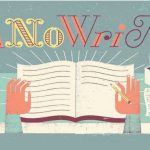Calling all novelists: NaNoWriMo brings opportunity to aspiring writers
National Novel Writing Month, better known as NaNoWriMo, is an annual creative writing project each November. Started in July 1999 by Chris Baty, the project has grown from a measly 21 participants in its first year to almost half a million in 2015. It later changed to November to allow writers to fully take advantage of the terrible weather and get focused. As this year’s contest comes to an end, many writers are already gearing up for next year’s by noting down ideas, beginning their research and forming groups to discuss this year’s and next year’s novels.
In an interview with The Huffington Post, Chris Baty found that working together in a group helped the writing process, and that it “ended up doing good things to their books and brains.” Baty said that it helped him to think of writing as a social activity, “If you want to get more writing done, try working in the same room with other writers. There’s just something about the sight and sound of people typing that makes it easier to get words on the page.”
As a registered nonprofit organization since 2005, NaNoWriMo encourages people to write from the first of Nov. at 12 a.m. to 11:59 p.m. on Nov. 30. If a person writes 50,000 words — the minimum number of words for a novel — they win. The prize is simply personal satisfaction for finishing that goal. The aim is to get people to be creative, to encourage people to write and to keep them motivated enough to finish the novel by the end of the month. There are tips on the website to keep people from getting writer’s block, and to help them continue to write. There are writer’s camps and events to connect with fellow aspiring novelists in your area.
The rules are simple — just write. Start on Nov. 1 and finish on Nov. 30. Anything written before, not including notes, cannot be counted. Participants can write in any genre they want to, about anything they want to. They only have to write 50,000 words by the end of the month. Among the half million that participated in 2015, 40,000 people won. The belief listed on their website is, “If you believe you’re writing a novel, then we believe you’re writing a novel too.”
Almost 250 novels have been published as results of NaNoWriMo; “The Pulse” by Shoshanna Evers, Marissa Meyer’s “Cinder” and my personal favourite, “Fangirl,” written by Rainbow Rowell, are just a few examples. Although most publishers discard books written as a first draft in NaNoWriMo, many welcome revised, edited entries from the year before. The founder of publishing house Candlemark and Gleam, Kate Sullivan, gives her two cents in an article on her company’s website. She says that there are usually a lot of “short, awful” manuscripts that begin with ‘I just finished my NaNoWriMo manuscript…’ She believes that some wonderful novels do come from this personal competition, however most of them require editing, “…but there may also be some gems.” Sullivan’s advice to prospective NaNoWriMo writers is to make their manuscripts longer than 50,000 words, between 80,000 to 100,000 instead, and to tirelessly revise them. “NaNoWriMo is about getting draft zero down. Write. Write like the wind,” Sullivan believes that this activity should be the first draft of many, many revisions and edits.
As someone who has spent countless hours this month staring at the bright screen of my laptop, I found that NaNoWriMo is a great way to get yourself out of that slump. All a person has to do is write even the silliest of ideas and keep working at them — they will accomplish the goal of 50,000 words and win. It takes countless cups of coffee and a few late nights to complete but the weariness is worth earning a badge on the website. The satisfaction is enough to keep a person going for days on end. Although this year’s contest has almost come to a close, people are strongly advised to begin preparation for next year. I began my process in January 2016, filling small notebooks with random thoughts and ideas. I began to create characters, write dialogue, gather research and outline the story. By being prepared to attack my novel on Nov. 1, I was able to get further than I ever thought I could and earned some pretty cool badges. Although I didn’t reach 50,000 this year, I got further than I have in previous years and plan on continuing to work on my novel until I finish. Be ready to tackle some writing goals by Nov. 1, 2017, and make it count. Start brainstorming today, create some characters — maybe even an entire fantasy world — and like everyone has been saying throughout this article, “just write.” NaNoWriMo could be the beginning of a great writing career.






